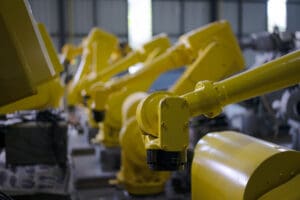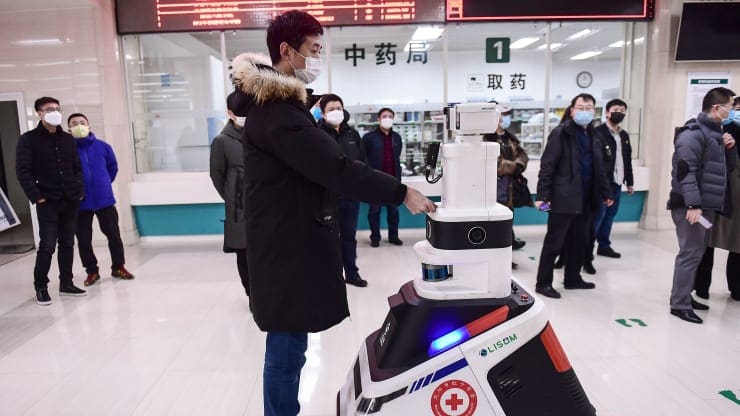Marvin Sepe, senior vice president of Irvine, California-based CTC Global, has been scrambling to get his company’s Chinese factory operating again after losing one month of production due to the coronavirus outbreak.
To reopen the company’s plant in the eastern Chinese city of Huaian, he must submit documents to the Chinese government for his 62 employees in China, listing their health status, recent travels, dates, quarantine and isolation periods. All but two workers have cleared the government-mandated health check. He also must make sure that the hi-tech plant, which makes conductor wires for the electric power grid, is disinfected.
CTC Global’s plant in China is more than 400 miles away from Wuhan, the center of the outbreak, but it’s not immune from the highly contagious virus. Still, the company has been able to tackle the issues better than many labor-intensive companies that are struggling to restart operations because they lack staff due to the quarantines, isolated periods, road blockages and checkpoints.
At CTC Global, fortunately, its Chinese plant is “highly automated already,” said Sepe. “Our plant is designed to be machine dominated, with low labor content.” CTC Global, which has a joint venture in China with large electric utility, State Grid Corp. of China, also operates a plant in Indonesia. For this reason, CTC Global is less vulnerable to the virus because its production is diversified geographically.
Getting back to work
As some 100 million factory workers return to China’s automotive, consumer electronics and smartphone makers, one clear, longer-term impact will be an emphasis on robotics and automation. Robotics can reduce labor costs and increase productivity — and prevent a recurrence of future plant shutdowns.
The COVID-19 disease has infected more than 87,000 people worldwide, with China accounting for 91% of cases. Globally the death toll has surpassed 3,000, according to the latest statistics from the World Health Organization.
The coronavirus has been a wake-up call for supply chain managers and risk managers in both China and the U.S., said Rosemary Coates, executive director of the Reshoring Institute in Silicon Valley. She points to how manufacturers such as agricultural and construction equipment maker Deere & Co. are assembling crisis teams to deal with product shortages.
Identifying ways to keep factory production going in those Chinese factories that have re-opened may include the use of more robots and other automation that substitute for humans. “China bought more robots last year than any country, and now is the time to put them to work,” Coates said.
Over the past several years, the world’s second-largest economy has been undergoing a so-called “robotics revolution.” Now, the impetus is greater than ever to embrace automation or be left behind. China has become the world’s largest market for industrial robotics and the fastest-growing market worldwide, surging 21% to $5.4 billion in 2019, while global sales hit $16.5 billion, according to the International Federation of Robotics in Frankfurt.
China’s robot revolution
China counts more than 800 robot makers, including major players SIASUN and DJI Innovations. Development of robotics is part of an ambitious Made in China 2025 master plan to upgrade the nation’s manufacturing technologies.
China is on track to account for 45% of all industrial robot shipments by 2021, up from 39% in 2019, predicts the robotics research group. In the past, China has lagged behind other nations in robotic workforces, counting 97 industrial robots per 10,000 manufacturing workers, half as many industrial robots as the U.S. and one-seventh as many as South Korea, according to the robotics group.
Clearly, the virus outbreak has put a “renewed urgency behind the trend towards increased automation and use of robotics in China,” says Emil Hauch Jensen, vice president of sales at Mobile Industrial Robots in Shanghai, which is fielding dozens of requests. The company’s autonomous robots, which can move pallets and heavy loads across warehouse and factories, are being used across a wide range of industries by large players such as Ford, Airbus, Flex, Honeywell and DHL.
Jensen points out the cost benefits: one robot that can work a 24-hour shift can replace three workers and cost in the range of $43,000 to $72,000. With salaries in China going up as much as 20% annually in recent years, China business consultant Bill Edwards, CEO of Edwards Global Services in Irvine, California, foresees an inevitable push to robotics. “Wages in China are no longer cheap,” he observed.
Getting production back on stream
U.S. companies with operations in China have been hit hard by the virus. A survey by the American Chamber of Commerce Shanghai found nearly half of the 109 companies polled in that city and metro area said lack of staff is their biggest challenge over the next few weeks, while two-thirds noted they don’t have sufficient staff to run a full production line. Another one-third indicated that logistics issues will be their biggest concern while nearly all the companies said they expected their supply chains to be impacted within the next month.
Industries that are most impacted are those with large assembly operations such as auto manufacturers and electronic component makers.

Tesla’s new multi-billion-dollar plant in Shanghai resumed operation Feb. 10 after a near two-week shutdown. The assembly line at the Chinese operation is less automated than at its main plant in Fremont, partly because local labor costs in China are lower than full automation. Strategizing to prevent further disruptions, Tesla is looking to completely localize its China supply chain by the end of this year but did not respond to an inquiry about any plans to increase automation.
Apple supplier Foxconn has been moving to automate 30% of its one million factory jobs in China by 2020, which could prove fortuitous. Foxconn cut 60,000 factory jobs from its 1.2 million China workforce in 2016, but further reductions have been slow to develop. The company has acknowledged that industrial robots can’t match the cognitive ability of humans. In the current crisis, plans to reboot the use of robots could be under review, but Foxconn hasn’t signaled such a move yet.
Apple said it doesn’t expect to hit its quarterly revenue targets because its iPhone manufacturing partners are located near the outbreak center in Hubei province and it has taken longer than expected to get operations back up and running.

Multinational automotive manufacturers in China, the world’s largest car market with sales of 28 million autos in 2019, are severely impacted. Wuhan, known as the Detroit of China, is a base for auto plants including General Motors, Honda, Nissan, Peugeot and Renault. With employees staying home and supply chain disrupted, getting back into production has been a struggle at many of these plants.
Operations such as Cadillac’s new Shanghai plant that are automated have a head start. Opened in 2016, the factory features 386 robots and two fully automated production lines that do welding and painting.
A national call to action
One overriding factor that could stall further use of robotics at operations within China is controversy about robots displacing blue collar jobs. The concern is about widespread unemployment, and potentially, social unrest. With an economic slowdown in China, that issue will be prominent.
Meanwhile, with travel and transportation bans in effect in China and stores, restaurants and schools closed, robots are being deployed for a wide variety of crucial services, from disinfecting hospitals and streets to delivering food, drugs and supplies.
Delivery robots are in high demand. In Wuhan, Chinese e-commerce giant JD.com is using a fleet of autonomous robotic vehicles to deliver essential goods to residents stuck at home homes and shopping online. The company’s automated warehouses have seen daily orders nearly double from 600,000 in one week during the crisis period.

In true quick-to-implement China style — and responding to multiple requests from manufacturers, retailers and offices — Chinese robot maker Youibot created a sterilization robot, start to finish in just 14 days, said Duncan Turner, managing director of the HAX Accelerator in Shenzhen. Youibot has just signed a contract with a huge manufacturer in Suzhou to disinfect the plant and has already delivered three robots and is starting to deploy 35 robots in Shenzhen by early March, he added.

Several other robotics start-ups have been called into service, said David Sullivan, managing director of business consultancy Alliance Development Group in Silicon Valley. He named Shenzhen-based startup Pudu Technology, which aims to reduce cross infection by home delivery of drugs and meals.
The large Chinese tech conglomerates also have been called into action. Alibaba’s logistics affiliate Cainiao, which opened China’s largest automated warehouse in Wuxi in 2018, uses 700 robots to streamline and speed up order fulfillment. It has recently launched a channel to deliver medical aid donations to areas in China hit by the highly contagious virus. These include Wuhan and neighboring cities in Hubei province.
Since the virus hit, Tencent has rolled out a feature in its popular WeChat messaging app that assigns health ratings to people via QR code. Chinese citizens have to scan their codes at subway stations, malls and office buildings, and can be turned away if they’re at high risk of carrying the virus.
In this environment, China tech innovation is being tested and reimagined at new levels.
Correction: This story has been updated to reflect that Marvin Sepe is senior vice president of Irvine, California-based CTC Global.



















